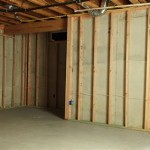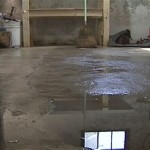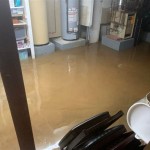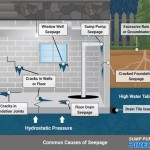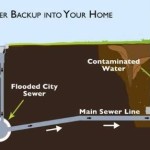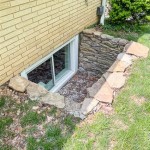How to Remove Mold From Basement Floor Joists
Mold growth on basement floor joists is a common problem, especially in humid climates. This can be a serious issue, jeopardizing the structural integrity of your home and posing health risks to its occupants. Mold thrives in damp, dark environments, and basement floor joists are often susceptible to moisture buildup due to leaks, poor ventilation, or even just high humidity. While removing mold can be a challenging task, it's essential to address it promptly to prevent further damage and health problems.
Identify the Source of Moisture
Before attempting to remove mold, it's crucial to identify and address the source of moisture. Without resolving the underlying issue, mold will likely reappear. Common sources of moisture include: *
Leaking pipes or plumbing fixtures:
Examine your plumbing system for leaks, particularly those located near or above the basement. *Poor ventilation:
Inadequate ventilation allows moisture to accumulate, creating a favorable environment for mold growth. Ensure proper ventilation in your basement, especially around crawl spaces and areas where there may be moisture traps. *High humidity:
Basements are naturally prone to high humidity, especially during the summer months. Dehumidifiers can help manage humidity levels and prevent mold growth. *Foundation cracks or leaks:
Cracks in your basement foundation can allow moisture to seep in, leading to mold problems. Inspect your foundation for any cracks or gaps and seal them with appropriate sealant. *Water seepage from the ground:
The soil around your foundation can also be a source of moisture, especially during periods of heavy rainfall. Ensure proper drainage around your foundation to prevent water infiltration.Safety Precautions
Mold removal involves working with potentially hazardous materials. It's essential to prioritize safety by taking the following precautions: *
Wear protective gear:
Always wear a respirator mask, gloves, and protective clothing to minimize exposure to mold spores. *Ventilate the area:
Open windows and doors to increase ventilation while working. *Use a HEPA filter:
Consider using a HEPA (High-Efficiency Particulate Air) filter vacuum cleaner to remove mold spores from the air. *Avoid disturbing dry mold:
Avoid disturbing dry mold as this can release mold spores into the air. *Consider professional assistance:
If you're dealing with extensive mold growth or have respiratory issues, it's recommended to consult a professional mold remediation expert for safe and effective removal.Removing the Mold
Once you've addressed the source of moisture and taken necessary safety precautions, you can proceed with mold removal: *
Remove affected materials:
For heavily contaminated wood, it's often best to replace it entirely. However, for minor mold infestations, you can try to salvage the wood by removing the mold. *Clean the mold:
Use a solution of bleach and water (1 part bleach to 10 parts water) to scrub the affected area. Be sure to wear protective gear and ventilate the area well. Alternatively, you can use a mold-killing solution specifically designed for wood. *Dry the area completely:
After cleaning, ensure the area is completely dry. Use fans, dehumidifiers, or a combination of both to speed up the drying process. *Prevent future mold growth:
Once the mold is removed, take steps to prevent its return. Ensure proper ventilation, manage humidity levels, and address any leaks or sources of moisture.Preventing Future Mold Growth
The best way to deal with mold is to prevent it from growing in the first place. Here are some tips to keep your basement mold-free: *
Maintain good ventilation:
Ensure adequate ventilation in your basement, especially around crawl spaces and areas prone to moisture buildup. *Control humidity levels:
Use a dehumidifier to manage humidity levels in your basement, particularly during humid seasons. *Seal cracks and leaks:
Inspect your foundation for cracks or gaps and seal them with appropriate sealant to prevent moisture infiltration. *Address leaks promptly:
Repair leaking pipes or faucets immediately to prevent moisture buildup. *Maintain a clean and dry basement:
Regular cleaning and drying will help prevent mold growth. *Inspect regularly:
Regularly inspect your basement for signs of moisture or mold growth. Early detection can help prevent major issues.By addressing the source of moisture, taking necessary safety precautions, and following the steps outlined above, you can effectively remove mold from your basement floor joists and prevent future growth. Remember, a clean and dry basement is essential for a healthy and safe home.

How To Remove Mold From Floor Joists Doityourself Com

Mold Removal From Crawlspace Floor Joists Greenbuildingadvisor

Is White Mold Dangerous How To Get Rid Of

Mold Growth On Joists In Crawlspace Environix

What Does Mold Treatment Cost Best Methods And Pricing Acculevel

Home Environment Solutions Mold Removal Photo Album Pittsburgh Pa Moldy Floor Joist

Mold Solutions By Cowleys Removal Services Photo Album Complete Basement Tear Out In Hazlet

Master Services Crawl Space Repair Photo Album Drainage Floor Joists Mold Remediation

Floor Joist Tar Heel Basement Systems

Crawl Space Mold Remediation In Toronto Markham Mississauga Moldy Spaces
